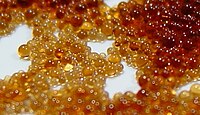
Photo from wikipedia
Abstract The utilization of waste polyvinyl chloride (PVC) as a membrane substrate and its hydrophilicity enhancement by incorporation of a sustainable biopolymer, gum arabic (GA) for natural organic matter (NOM)… Click to show full abstract
Abstract The utilization of waste polyvinyl chloride (PVC) as a membrane substrate and its hydrophilicity enhancement by incorporation of a sustainable biopolymer, gum arabic (GA) for natural organic matter (NOM) removal in water, was studied in this research. Phase transformation method was used for membrane preparation by varying the percentage of GA. Interactions between waste PVC and GA at different loadings (1–5 wt. %) were analyzed using various analytical techniques for morphology and evaluation studies. Field emission scanning electron microscopy, thermogravimetric analysis, Fourier transforms infrared spectroscopy, equilibrium water content, contact angle, porosity, water flux, and compaction factor were assessed. Furthermore, the assessment of NOM removal from water was also studied. It was found that blending of waste PVC with GA enhanced its hydrophilicity by 25%, improved its water permeation from 51 to 98 L/m2h, with a flux recovery ratio of around 80%, and a rejection of around 96%. The onset degradation temperature was also improved by ∼30 °C and the mechanical strength was enhanced by ∼ 1.2 MPa. The present study depicts the outcome of the incorporation of GA as a green alternative additive for enhancing the performance of waste PVC based membranes in water treatment applications.
Journal Title: Journal of water process engineering
Year Published: 2020
Link to full text (if available)
Share on Social Media: Sign Up to like & get
recommendations!